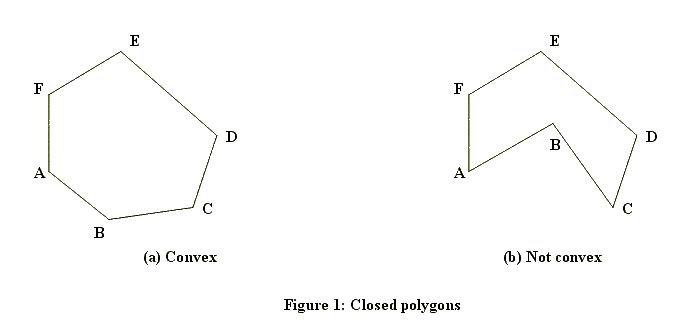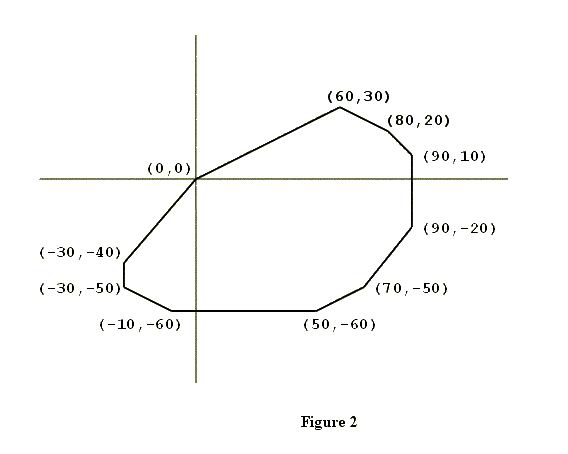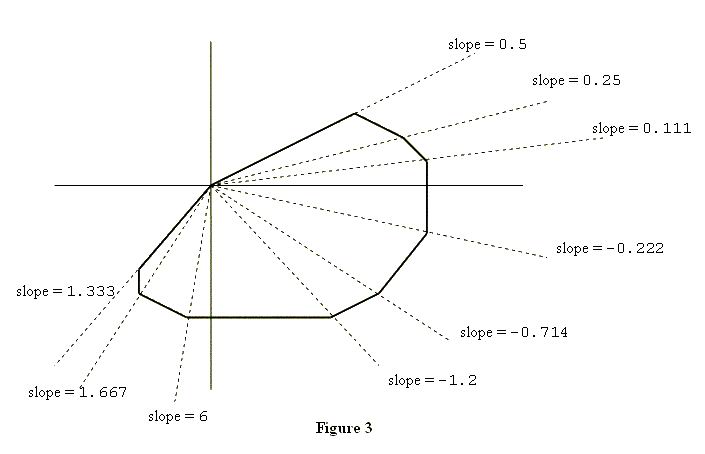Scrambled Polygon (极角排序)
来源:互联网 发布:淘宝怎么增加权重 编辑:程序博客网 时间:2024/05/16 16:06
Language:
Scrambled Polygon
Time Limit: 1000MS Memory Limit: 30000KTotal Submissions: 7629 Accepted: 3630
Description
A closed polygon is a figure bounded by a finite number of line segments. The intersections of the bounding line segments are called the vertices of the polygon. When one starts at any vertex of a closed polygon and traverses each bounding line segment exactly once, one comes back to the starting vertex.
A closed polygon is called convex if the line segment joining any two points of the polygon lies in the polygon. Figure 1 shows a closed polygon which is convex and one which is not convex. (Informally, a closed polygon is convex if its border doesn't have any "dents".)

The subject of this problem is a closed convex polygon in the coordinate plane, one of whose vertices is the origin (x = 0, y = 0). Figure 2 shows an example. Such a polygon will have two properties significant for this problem.
The first property is that the vertices of the polygon will be confined to three or fewer of the four quadrants of the coordinate plane. In the example shown in Figure 2, none of the vertices are in the second quadrant (where x < 0, y > 0).
To describe the second property, suppose you "take a trip" around the polygon: start at (0, 0), visit all other vertices exactly once, and arrive at (0, 0). As you visit each vertex (other than (0, 0)), draw the diagonal that connects the current vertex with (0, 0), and calculate the slope of this diagonal. Then, within each quadrant, the slopes of these diagonals will form a decreasing or increasing sequence of numbers, i.e., they will be sorted. Figure 3 illustrates this point.


A closed polygon is called convex if the line segment joining any two points of the polygon lies in the polygon. Figure 1 shows a closed polygon which is convex and one which is not convex. (Informally, a closed polygon is convex if its border doesn't have any "dents".)

The subject of this problem is a closed convex polygon in the coordinate plane, one of whose vertices is the origin (x = 0, y = 0). Figure 2 shows an example. Such a polygon will have two properties significant for this problem.
The first property is that the vertices of the polygon will be confined to three or fewer of the four quadrants of the coordinate plane. In the example shown in Figure 2, none of the vertices are in the second quadrant (where x < 0, y > 0).
To describe the second property, suppose you "take a trip" around the polygon: start at (0, 0), visit all other vertices exactly once, and arrive at (0, 0). As you visit each vertex (other than (0, 0)), draw the diagonal that connects the current vertex with (0, 0), and calculate the slope of this diagonal. Then, within each quadrant, the slopes of these diagonals will form a decreasing or increasing sequence of numbers, i.e., they will be sorted. Figure 3 illustrates this point.


Input
The input lists the vertices of a closed convex polygon in the plane. The number of lines in the input will be at least three but no more than 50. Each line contains the x and y coordinates of one vertex. Each x and y coordinate is an integer in the range -999..999. The vertex on the first line of the input file will be the origin, i.e., x = 0 and y = 0. Otherwise, the vertices may be in a scrambled order. Except for the origin, no vertex will be on the x-axis or the y-axis. No three vertices are colinear.
Output
The output lists the vertices of the given polygon, one vertex per line. Each vertex from the input appears exactly once in the output. The origin (0,0) is the vertex on the first line of the output. The order of vertices in the output will determine a trip taken along the polygon's border, in the counterclockwise direction. The output format for each vertex is (x,y) as shown below.
Sample Input
0 070 -5060 30-30 -5080 2050 -6090 -20-30 -40-10 -6090 10
Sample Output
(0,0)(-30,-40)(-30,-50)(-10,-60)(50,-60)(70,-50)(90,-20)(90,10)(80,20)(60,30)
转,只需要判断x1*y2-x2*y1(这个又是叉积吧!!!) 的正负。将第一个点作为参照进行极角排序
#include<stdio.h>#include<iostream>#include<algorithm>using namespace std;struct point{ int x,y;}A[55];int cp(point p1,point p2,point p3){ return (p1.x*p3.y-p3.x*p1.y)-(p2.x*p3.y-p3.x*p2.y);}bool cmp(point a,point b){ return cp(A[0],a,b)<0;}int main(){ int n=0; while(scanf("%d%d",&A[n].x,&A[n].y)!=EOF) n++; sort(A+1,A+n,cmp); for(int i=0;i<n;i++) { printf("(%d,%d)\n",A[i].x,A[i].y); }} 1 0
- Scrambled Polygon (极角排序)
- poj2007-Scrambled Polygon (极角排序)
- poj 2007 Scrambled Polygon(极角排序)
- POJ 2007 Scrambled Polygon(简单极角排序)
- POJ 2007:Scrambled Polygon (极角排序)
- poj 2007 Scrambled Polygon 极角排序
- POJ 2007 Scrambled Polygon(极角排序)
- POJ 2007 Scrambled Polygon 极角排序
- HDU-2007 Scrambled Polygon 极角排序
- poj 2007 Scrambled Polygon [极角排序]
- POJ 2007 Scrambled Polygon 极角排序
- PKU 2007 Scrambled Polygon 极角排序
- poj 2007 Scrambled Polygon 【极角排序】
- POJ 2007 Scrambled Polygon(极角排序)
- POJ 2007 Scrambled Polygon (极角排序)
- poj2007 Scrambled Polygon【极角排序】
- Scrambled Polygon(poj2007极角排序输出凸包)
- POJ 2007 Scrambled Polygon(点的极角排序)
- 第二章 算法基础
- OC基础DAY04 - 继承与多态
- 常用算法 - 分治算法
- S5P4418启动镜像分析
- js单链式运算
- Scrambled Polygon (极角排序)
- 数据类型_MySQL
- OC基础DAY05 - 点语法和构造方法
- iOS开发- 启动动画(动态欢迎界面,非静态Default)
- leetcode 85.Maximal Rectangle
- 图片与文字产生联动效果,外带不可用效果(disabled)
- PCB课程设计4(创建原理图元器件库)
- 一个标准的HTML5语义化页面
- OC加强DAY01 - 内存管理MRC


